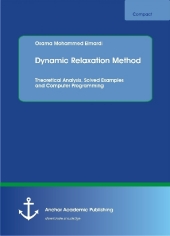 Neuerscheinungen 2016Stand: 2020-02-01 |
Schnellsuche
ISBN/Stichwort/Autor
|
Herderstraße 10
10625 Berlin
Tel.: 030 315 714 16
Fax 030 315 714 14
info@buchspektrum.de |

Osama Mohammed Elmardi
Dynamic Relaxation Method. Theoretical Analysis, Solved Examples and Computer Programming
2016. 44 S. 220 mm
Verlag/Jahr: ANCHOR ACADEMIC PUBLISHING 2016
ISBN: 3-9606708-4-2 (3960670842)
Neue ISBN: 978-3-9606708-4-1 (9783960670841)
Preis und Lieferzeit: Bitte klicken
This book is suitable as a textbook for a first course on the Dynamic Relaxation technique in civil and mechanical engineering curricula. It can be used as a reference by engineers and scientists working in the industrial sector and in academic institutions.
The first chapter includes an introduction to the Dynamic Relaxation method (DR) which is combined with the Finite Differences method (FD) for the sake of solving ordinary and partial differential equations, as a single equation or as a group of differential equations. In this chapter the dynamic relaxation equations are transformed to artificial dynamic space by adding damping and inertia effects. These are then expressed in finite difference form and the solution is obtained through iterations.
The procedural steps in solving differential equations using the DR method were applied to the system of differential equations (i.e. ordinary and/or partial differential equations). The DR program performs the following operations: Reads data file; computes fictitious densities; computes velocities and displacements; checks stability of numerical computations; checks convergence of solution; and checks wrong convergence. At the end the Dynamic Relaxation numerical method coupled with the Finite Differences discretization technique is used to solve nonlinear ordinary and partial differential equations. Subsequently, a FORTRAN program is developed to generate the numerical results as analytical and/or exact solutions.
Text sample:
Chapter 2.1.1 Numerical Instability:
In every iteration, the value of the function at the center of the solution domain or other suitable point is compared with two estimated reference values representing lower and upper bounds of the function at that point. If solution was failed such that the computed value of the function at the specified point did not fall within the prescribed range, the solution is deemed unstable, and therefore iterations are terminated. The damping coefficients are then reduced and the process of iteration is restarted once again. The iterations are repeated several times until stability is reached.
2.1.2 Convergence of DR Solution:
Convergence of the dynamic relaxation solution is checked at the end of each iteration by comparing the velocities over the domain with a prescribed value. The procedure is repeated until the solution is deemed converged and consequently the iterative process is terminated.
2.1.3 Convergence to an Invalid Solution:
Sometimes DR solution converges to incorrect answer. Check for invalid solution is carried out after the solution has satisfied the convergence criterion explained earlier. In the check procedure the profile of variable is compared with the anticipated profile over the domain. For instance, if the value of the function on the boundaries is zero, and it is known that the function increases from edge to center, then the solution should follows a similar profile. If the computed profile is different from that, the solution is deemed to be incorrect. When this happens, the solution can hardly be made to converge to the correct answer by altering the damping coefficients and time increment. One should take another look to the boundary conditions and correct them if they are wrong.
2.1.4 Time Increment:
Proper time increment is a very important factor for speeding convergence and controlling numerical computations. When time increment is too small, convergence becomes tediously slow; and if it is too large, the solution becomes unstable. Time increment must be less than 1, say, 0.8.
2.1.5 Damping Coefficient:
The optimum damping coefficient is that which produces critical motion. When the damping coefficient or coefficients are large, the motion is over - damped and convergence becomes very slow. When the coefficients are small, the motion is under - damped and can cause numerical instability.


